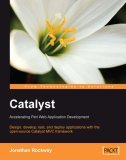
Catalyst is a web framework for Perl, which claims to "make web development something you had never expected it to be: Fun, rewarding and quick".
I’m a professional Perl developer, but hadn’t tried Catalyst – it was one of the things I really wanted to try out but didn’t get round to it. Recently I obtained a copy of Johnathan Rockway’s book, Catalyst (Accelerating Perl Web Application Development) from PACKT publishing, so here’s a review of the book.
Johnathan is a member of the core Catalyst development team and certainly knows his stuff, so that lends credence to this book.
My first impression was that the book is somewhat thin at 187 pages for its £24.99 ($39.99 USD) cover price.
However, reading through the book, it covers Catalyst and some of the modules commonly used with Catalyst in just the right amount of detail – if you have some experience with Perl already, this book will give you just what you need to get using Catalyst with the minimum of fuss. The also covers various related tasks you’ll want to do when developing web apps with Catalyst, including:
- using Template::Toolkit to generate output
- object-relational mapping with DBIx::Class
- generating forms automatically with FormBuilder
- authentication and authorisation
- session management
- adding REST APIs, AJAX interactivity and RSS feeds
So, overall, I’d say it’s a quite good book, a perfect introduction to developing maintainable web applications using Catalyst, and using current best practices including MVC designs and ORM database access. However, one thing I felt wasn’t covered very well was Perl’s attributes which are used in many code examples – that’s one area of Perl that I haven’t really made any use of up until now. (The perldoc page does warn that "attribute declarations for variables are still evoving. The semantics and interfaces of such declarations could change in future versions. They are present for purposes of experimentation with what the semantics ought to be. Do not rely on the current implementation of this feature."). The book fails to really describe attributes at all (which I suspect is something a fair number of Perl developers won’t be familiar with). It also doesn’t explain the principles behind MVC design; I guess it’s a reasonable assumption that anyone planning to use Catalyst will probably already be fairly familiar with MVC principles, but a better introduction (perhaps with pointers to external reading for those needing to learn more first) wouldn’t have hurt.
Also, unfortunately the book is marred by several typos – it exudes a feel of perhaps being rushed out a little, without enough time being spent on editing. I don’t feel it detracts badly from the book, but is a little shoddy.
Despite the flaws, I still feel it’s a useful book to help get to grips with Catalyst.
Grab yourself a copy from Amazon (price at time of writing: £23.74), or buy it direct from Packt for £22.49.

